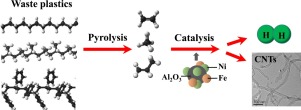Applied Catalysis B: Environment and Energy ( IF 20.2 ) Pub Date : 2017-09-17 , DOI: 10.1016/j.apcatb.2017.09.035 Dingding Yao , Yeshui Zhang , Paul T. Williams , Haiping Yang , Hanping Chen

|
The use of Ni-Fe catalysts for the catalytic pyrolysis of real-world waste plastics to produce hydrogen and high value carbon nanotubes (CNT), and the influence of catalyst composition and support materials has been investigated. Experiments were conducted in a two stage fixed bed reactor, where plastics were pyrolysed in the first stage followed by reaction of the evolved volatiles over the catalyst in the second stage. Different catalyst temperatures (700, 800, 900 °C) and steam to plastic ratios (0, 0.3, 1, 2.6) were explored to optimize the product hydrogen and the yield of carbon nanotubes deposited on the catalyst. The results showed that the growth of carbon nanotubes and hydrogen were highly dependent on the catalyst type and the operational parameters. Fe/γ-Al2O3 produced the highest hydrogen yield (22.9 mmol H2/gplastic) and carbon nanotubes yield (195 mg g−1plastic) among the monometallic catalysts, followed by Fe/α-Al2O3, Ni/γ-Al2O3 and Ni/α-Al2O3. The bimetallic Ni-Fe catalyst showed higher catalytic activity in relation to H2 yield than the monometallic Ni or Fe catalysts because of the optimum interaction between metal and support. Further investigation of the influence of steam input and catalyst temperature on product yields found that the optimum simultaneous production of CNTs (287 mg g−1plastic) and hydrogen production (31.8 mmol H2/gplastic) were obtained at 800 °C in the absence of steam and in the presence of the bimetallic Ni-Fe/γ-Al2O3 catalyst.
中文翻译:

从现实世界的废塑料中联合生产氢和碳纳米管:催化剂成分和操作参数的影响
使用镍铁催化剂催化裂解现实世界的废塑料以生产氢气和高价值的碳纳米管(CNT),并研究了催化剂组成和载体材料的影响。在两阶段固定床反应器中进行实验,其中在第一阶段将塑料热解,然后在第二阶段使析出的挥发物在催化剂上反应。探索了不同的催化剂温度(700、800、900°C)和水蒸气与塑料的比例(0、0.3、1、2.6),以优化产物氢和沉积在催化剂上的碳纳米管的产率。结果表明,碳纳米管和氢气的生长高度依赖于催化剂的类型和操作参数。的Fe /γ-Al系2 ö 3产生最高产氢(22.9毫摩尔ħ 2 / g的塑料)和碳纳米管得到(195毫克克-1塑料)的单金属催化剂中,随后的Fe /α-Al系2 ö 3,镍/γ-Al系2 ö 3和Ni /α-Al系2 ö 3。由于金属与载体之间的最佳相互作用,双金属Ni-Fe催化剂相对于H 2产率显示出比单金属Ni或Fe催化剂更高的催化活性。进一步研究蒸汽输入和催化剂温度对产物收率的影响,发现最佳同时生产CNT(287 mg g -1塑料)和氢生产(31.8毫摩尔ħ 2 / g的胶在800℃下在不存在蒸汽的和在双金属镍-铁/γ-Al的存在下获得)2 ö 3催化剂。











































 京公网安备 11010802027423号
京公网安备 11010802027423号